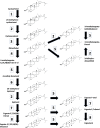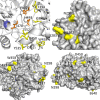Sterol Biosynthesis in Four Green Algae: A Bioinformatic Analysis of the Ergosterol Versus Phytosterol Decision Point
- PMID: 33713347
- PMCID: PMC8453531
- DOI: 10.1111/jpy.13164
Sterol Biosynthesis in Four Green Algae: A Bioinformatic Analysis of the Ergosterol Versus Phytosterol Decision Point
Abstract
Animals and fungi produce cholesterol and ergosterol, respectively, while plants produce the phytosterols stigmasterol, campesterol, and β-sitosterol in various combinations. The recent sequencing of many algal genomes allows the detailed reconstruction of the sterol metabolic pathways. Here, we characterized sterol synthesis in two sequenced Chlorella spp., the free-living C. sorokiniana, and symbiotic C. variabilis NC64A. Chlamydomonas reinhardtii was included as an internal control and Coccomyxa subellipsoidea as a plant-like outlier. We found that ergosterol was the major sterol produced by Chlorella spp. and C. reinhardtii, while C. subellipsoidea produced the three phytosterols found in plants. In silico analysis of the C. variabilis NC64A, C. sorokiniana, and C. subellipsoidea genomes identified 22 homologs of sterol biosynthetic genes from Arabidopsis thaliana, Saccharomyces cerevisiae, and C. reinhardtii. The presence of CAS1, CPI1, and HYD1 in the four algal genomes suggests the higher plant cycloartenol branch for sterol biosynthesis, confirming that algae and fungi use different pathways for ergosterol synthesis. Phylogenetic analysis for 40 oxidosqualene cyclases (OSCs) showed that the nine algal OSCs clustered with the cycloartenol cyclases, rather than the lanosterol cyclases, with the OSC for C. subellipsoidea positioned in between the higher plants and the eight other algae. With regard to why C. subellipsoidea produced phytosterols instead of ergosterol, we identified 22 differentially conserved positions where C. subellipsoidea CAS and A. thaliana CAS1 have one amino acid while the three ergosterol producing algae have another. Together, these results emphasize the position of the unicellular algae as an evolutionary transition point for sterols.
Keywords: Chlorella sorokiniana; Chlorella variabilis NC64A; Clotrimazole; Coccomyxa subellipsoidea; Ketoconazole; algal sterol composition; oxidosqualene cyclase; terbinafine.
© 2021 The Authors. Journal of Phycology published by Wiley Periodicals LLC on behalf of Phycological Society of America.
Figures




References
Publication types
MeSH terms
Substances
Grants and funding
LinkOut - more resources
Full Text Sources
Other Literature Sources
Miscellaneous

